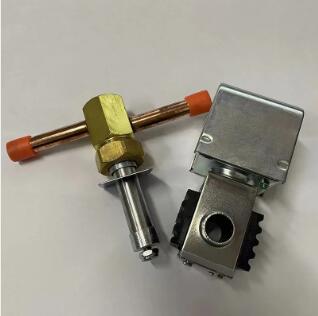The Role of High-Speed Refrigeration Solenoid Valves in Enhancing System Efficiency and Performance
2024-08-28
Introduction
Refrigeration systems are the backbone of numerous industries, ensuring that perishable goods, sensitive materials, and critical processes are maintained at optimal temperatures. At the heart of these systems are components that regulate the flow and distribution of refrigerants, one of which is the high-speed refrigeration solenoid valve. In this blog, we will delve into the role of high-speed solenoid valves in enhancing the efficiency and performance of refrigeration systems, exploring their design, operation, and the advantages they bring to various applications.
How High-Speed Refrigeration Solenoid Valves Work
A high-speed refrigeration solenoid valve operates by using electromagnetic force to control the movement of a plunger or piston within the valve body. This plunger either opens or closes the valve, regulating the flow of refrigerant through the system. When an electrical current is applied to the solenoid coil, it generates a magnetic field that pulls the plunger upward, opening the valve. When the current is removed, a spring or gravity returns the plunger to its original position, closing the valve.
The "high-speed" aspect refers to the rapid response time of these valves, which is crucial for applications requiring quick and precise control of refrigerant flow. The fast actuation of these valves enables the system to make real-time adjustments to changing conditions, such as variations in load or temperature.
Advantages of High-Speed Solenoid Valves in Refrigeration Systems
1. Enhanced Temperature Control:
- One of the most significant advantages of high-speed solenoid valves is their ability to provide enhanced temperature control. By quickly adjusting the flow of refrigerant, these valves help maintain stable temperatures within the system, preventing overheating or overcooling and ensuring the system operates within its optimal range.
2. Reduced Energy Consumption:
- Energy efficiency is a critical consideration in modern refrigeration systems, and high-speed solenoid valves contribute to this by minimizing energy wastage. The rapid response of these valves ensures that the system only uses the amount of refrigerant necessary to maintain the desired temperature, reducing the workload on compressors and other components.
3. Improved System Reliability:
- The quick actuation and precise control offered by high-speed solenoid valves lead to improved system reliability. By reducing the risk of temperature fluctuations and ensuring that refrigerant flow is accurately controlled, these valves help prevent issues such as compressor overload, which can lead to system failures.
4. Minimized Downtime:
- In industries where refrigeration systems are critical to operations, downtime can be costly. High-speed solenoid valves help minimize downtime by providing reliable performance and reducing the frequency of maintenance. Their durable construction and ability to handle rapid cycling make them less prone to wear and tear, extending the overall lifespan of the system.
5. Versatility Across Applications:
- High-speed solenoid valves are versatile components that can be used in a wide range of refrigeration and cooling applications. From commercial refrigeration units to industrial cooling systems and even specialized cryogenic applications, these valves offer the flexibility needed to meet the demands of various industries.
Design Considerations for High-Speed Solenoid Valves
1. Material Selection:
- The materials used in the construction of high-speed solenoid valves are crucial to their performance and durability. Common materials include stainless steel for corrosion resistance, brass for its machinability, and various plastics for lightweight and non-corrosive applications. The choice of material depends on the specific requirements of the application, such as the type of refrigerant used and the operating environment.
2. Valve Size and Capacity:
- The size and capacity of the valve must be carefully selected to match the requirements of the system. A valve that is too small may not provide adequate flow control, while a valve that is too large could lead to inefficiencies and increased energy consumption. Engineers must consider factors such as the system’s cooling load, pressure requirements, and refrigerant type when selecting the appropriate valve.
3. Response Time:
- The response time of the solenoid valve is a critical factor in its performance. High-speed valves are designed to open and close rapidly, typically within milliseconds, ensuring that the system can make quick adjustments to changing conditions. This rapid response is essential for maintaining temperature stability and energy efficiency in dynamic environments.
Applications of High-Speed Refrigeration Solenoid Valves
1. Food and Beverage Industry:
- In the food and beverage industry, maintaining precise temperatures is essential for preserving the quality and safety of products. High-speed solenoid valves ensure that refrigeration systems can quickly adapt to changes in load, such as when large quantities of products are added or removed from storage.
2. Pharmaceutical Industry:
- The pharmaceutical industry relies on precise temperature control to ensure the stability and efficacy of drugs and vaccines. High-speed solenoid valves are used in refrigeration systems that store sensitive products, providing the rapid response needed to maintain consistent temperatures.
3. HVAC Systems:
- In HVAC (heating, ventilation, and air conditioning) systems, high-speed solenoid valves are used to control the flow of refrigerants in air conditioning units. Their fast response ensures that the system can quickly adjust to changes in temperature and humidity, providing optimal comfort for building occupants.
Conclusion
High-speed refrigeration solenoid valves are essential components that significantly enhance the efficiency, performance, and reliability of refrigeration systems. Their ability to provide rapid and precise control over refrigerant flow makes them indispensable in a wide range of applications, from commercial refrigeration to industrial cooling and beyond. By understanding the advantages and design considerations of these valves, engineers and operators can make informed decisions that optimize the performance and longevity of their cooling systems.



